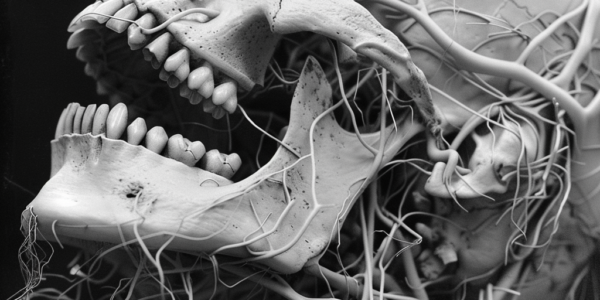Archaeological Study Suggests Cultural Diversity Increases Biodiversity of Ecosystems
Recent archaeological study suggests that cultural diversity has a positive effect on the biodiversity of ecosystems. The research challenges the idea that humans lived harmoniously with nature as hunter-gatherers and emphasizes the complex relationship between human cultural diversity and ecosystem biodiversity.
Study Reveals Surprising Findings on Virus Host Transmission
A recent study has revealed surprising findings on virus host transmission, suggesting that anthroponotic transmission may be more common than previously thought. The study, conducted by scientists from the UK, analyzed nearly 60,000 viral genomes and highlighted the prevalence of viruses transmitted from humans to animals. The research underscores the bidirectional nature of virus host dynamics and emphasizes the importance of comprehensive surveillance and research efforts in understanding and mitigating the risks posed by emerging infectious diseases.
Study Reveals Humans Transmitting Viruses to Animals, Not Just the Other Way Around
A new study by researchers from University College London reveals the potential risks of humans transmitting viruses to animals, rather than the other way around. The study emphasizes the need to consider humans as just one node in a vast network of hosts endlessly exchanging pathogens. The research, published in Nature Ecology and Evolution, also highlighted the evolution of these viruses and the potential implications for both animals and humans. The findings underscore the need for a more comprehensive approach to addressing the risks associated with the transmission of viruses between humans and animals.
Captivating Images of the Human Body
Explore a collection of astonishing photos that provide a glimpse into the extraordinary aspects of the human body, from MRI kisses to rare medical conditions. These captivating images showcase the resilience, uniqueness, and occasional quirks of the human body, offering a reminder of its awe-inspiring complexity.
Ancient Stone Points Unearthed in Ethiopia
Groundbreaking discovery in Ethiopia as stone points dating back 74,000 years shed light on ancient human adaptability. The archaeological site has yielded evidence of hunter-gatherer resourcefulness and ability to thrive in changing circumstances. The findings offer valuable insights into human migration and settlement, showcasing the resilience and ingenuity of our ancestors.
The Mystery of Human Speech: Unraveling the Enigma
The mystery of human speech has puzzled scientists and linguists for centuries. The origins of spoken language, a defining characteristic of our species, remain shrouded in mystery. Researchers have proposed various theories to account for the development of human speech, but the precise origins continue to elude definitive explanation. Advances in genetics, neuroscience, and archaeology have provided new avenues for investigating the origins of human speech, while the study of non-human communication systems has offered valuable comparative insights. The quest to understand how humans learned to speak remains an enduring enigma, driving ongoing exploration and discovery in the fascinating field of language evolution.
Study Reveals How Exposure to Music Influences Brain’s Interpretation of Rhythm
Discover the latest neuroscience news on how exposure to different types of music affects the brain’s interpretation of rhythm. A study involving participants from 15 countries reveals the brain’s bias toward simple integer ratios and how this preference varies across cultures. Published in Nature Human Behaviour, the research sheds light on the evolution of the brain’s error-correction system and its impact on music perception.
Scientists Discover Viroidlike ‘Obelisks’ Colonizing Bacteria in Human Gut
Scientists have made a groundbreaking discovery in the human gut, finding rod-shaped fragments of RNA called ‘obelisks’ colonizing bacteria for the first time. This discovery may represent a whole new class of infectious agent, according to a study available on the preprint server bioRxiv. The lead author, Ivan Zheludev of Stanford University, and his colleagues identified thousands of distinct loops of single-stranded RNA that did not code for proteins. They even found one group of obelisks inside the common mouth bacterium Streptococcus sanguinis. Additionally, they analyzed information on the mouth and gut microbiomes of 472 people from five previous studies and detected obelisks in nearly 10 percent of the participants. These obelisks bear some resemblance to viroids, tiny, circular fragments of single-stranded RNA. However, they differ in their shape and structure, being rolled into a rod shape instead of remaining a flat circle, and their RNA sequences don’t match any known viroid sequences. Moreover, they are the first viroidlike elements to be detected in bacterial cells, rather than in more complex organisms. Understanding and classifying these obelisks will be an intriguing challenge, as they blur the line between living and nonliving things. Given the ubiquity of viroids in the plant world, finding something similar in bacteria makes perfect sense, and it is an exciting discovery in the field of microbiology.
Global Longevity Trends: Humans Living Longer than Ever
Research shows that humans are living longer than ever, with mortality and longevity trends becoming more similar regardless of disparities between sexes and locations. The male-female gap in life expectancy is decreasing, and clusters of countries are projected to change further by 2030. Despite challenges such as war, poverty, and disease, life spans are expected to continue to grow longer.
Groundbreaking Discovery in Genomics: Researchers Shed Light on Behavior of Transposable Elements in Human Genome
Scientists at Ecole Polytechnique Federale de Lausanne have made a groundbreaking discovery in the field of genomics. Their research, published in Cell Genomics, sheds light on the mysterious behavior of transposable elements (TEs) within the human genome. TEs are segments…










